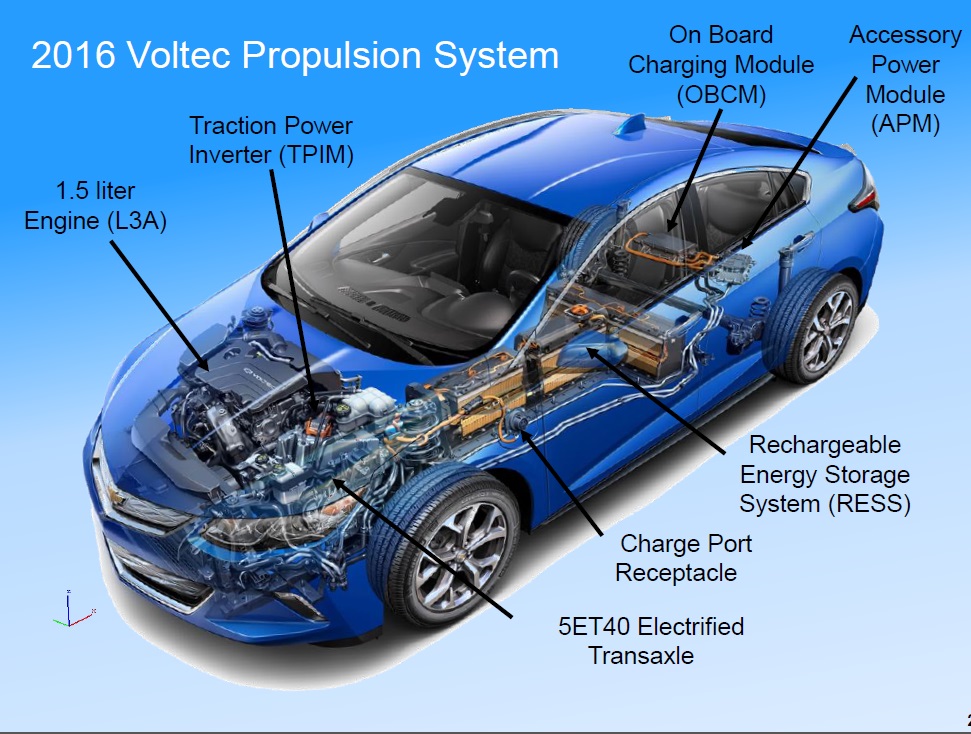The distinguishing feature of the Chevrolet Volt has always been that as long as it has charge left in its battery, it runs solely on electricity.
The gasoline engine doesn't switch on even under maximum acceleration (except in certain cold-weather situations, to provide heat for the cabin and battery).
The new 2016 Chevy Volt maintains that feature, and expands its electric range from 38 to 50 miles--ensuring even more all-electric travel.
DON'T MISS: 2016 Chevrolet Volt: 50-Mile Range, 41 MPG, Five Seats, All New (Photos)
But with a variety of other plug-in hybrids on the market--from BMW, Ford, Honda, Porsche, Toyota, and soon Audi and Mercedes-Benz as well--why are the Volt and its Cadillac ELR relative the sole vehicles to behave that way?
The answer is that it simply requires a larger battery pack and a more powerful electric motor than the other makers have chosen to fit.

2016 Chevrolet Volt plug-in hybrid - details of Voltec drivetrain from SAE presentations, Feb 2015
In an interview with Pete Savagian, general director of electric drives and systems engineering, and Tim Grewe, chief engineer for vehicle electrification, the two GM engineers explained that the Volt was designed that way from the very start.
"We sized the pack and designed the [different operating mode] efficiencies to get 50 miles of range," said Grewe.
RELATED: 2016 Chevrolet Volt Powertrain: How It Works In Electric, Hybrid Modes
A larger battery pack is obviously needed to provide the energy: "That 18.4 kilowatt-hours [in the 2016 Volt battery] was a big part of our 50 miles," Grewe said.
But fewer people seem to recognize that the power that can sustainably be delivered to the drive motor(s) is also proportional to the energy capacity of the battery pack

2016 Chevrolet Volt plug-in hybrid - details of Voltec drivetrain from SAE presentations, Feb 2015
Quite simply, "the pack has to be a certain size" to deliver the all-electric running that "users love...even under maximum demand."
He pointed out that the 120 kilowatts (160 horsepower) of peak power that can be delivered by the new 2016 Volt is the highest electric output in any plug-in hybrid on the market.
ALSO SEE: 2016 Chevy Volt: Bigger Battery, More Motor Power, New Range Extender Engine Details
The identical powertrains of Ford C-Max and Fusion Energi plug-in hybrids, for example, have battery packs of only 7.6 kWh and their maximum motor output is 88 kw (118 hp).
That gives them a revised range rating of 19 miles, just 40 percent of the 2016 Volt's.
And the low-volume Honda Accord Plug-In Hybrid's battery holds only 6.7 kWh, meaning its maximum power in electric mode alone is limited (and its range is only 13 miles).

BMW 5-Series GT development prototype for Power eDrive plug-in hybrid system, Nov 2014
So, despite a motor output of 124 kw (166 hp), the plug-in Accord too switches on its engine when sustained power is demanded, as we experienced during our road test.
Over time, it's likely that more plug-in hybrids will move toward a Volt-like arrangement in which electric running is provided full-time as long as battery capacity holds out.
The BMW Power eDrive system, unveiled last fall, uses a 200-kW (268-hp) electric motor to power the rear wheels of a concept vehicle.
MORE: Is The 2016 Chevy Volt GM's Future Hybrid System In Disguise?
A combined engine-motor-transmission combination powers the front wheels as well, with motor output of 150 kw (201 hp).
Combined with battery packs of up to 20 kilowatt-hours, the output of these systems will be more than 500 kW (670 hp).
That means, as BMW notes, that the vehicle can operate solely on electric power throughout fully two-thirds of its usage cycle, maximizing its efficiency.
_________________________________________________













